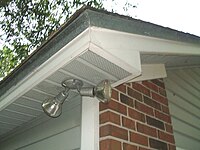**Etymology of Soffit:**
– The term ‘soffit’ is derived from the Italian word ‘soffitto’, which originally meant a ceiling.
– Its root can be traced back to the Latin word ‘suffictus’ or ‘suffixus’, indicating to fix underneath.
**Soffits in Construction:**
– In architecture, a soffit refers to the underside of any construction element.
– Soffits and fascias are commonly attached to rafters using screws or nails.
– The depth of the soffit exposure profile on a building’s exterior can vary.
– Soffits can be either non-ventilated or ventilated to prevent condensation.
– A soffit vent is a grill covering the venting opening on the bottom of the soffit.
**Related Topics:**
– The use of copper in architecture is associated with soffits.
**References:**
– Information on range hood installation under sloped/high ceilings by Futuro Futuro.
– Incorporation of text from a 1911 publication in the public domain in this article.
This article needs additional citations for verification. (December 2017) |
A soffit is an exterior or interior architectural feature, generally the horizontal, aloft underside of any construction element. Its archetypal form, sometimes incorporating or implying the projection of beams, rafters or trusses over the exterior of supporting walls, is the underside of eaves (to connect a supporting wall to projecting edge(s) of the roof). The vertical band at the edge of the roof is called a fascia. A soffit of an arch is frequently called an intrados.




